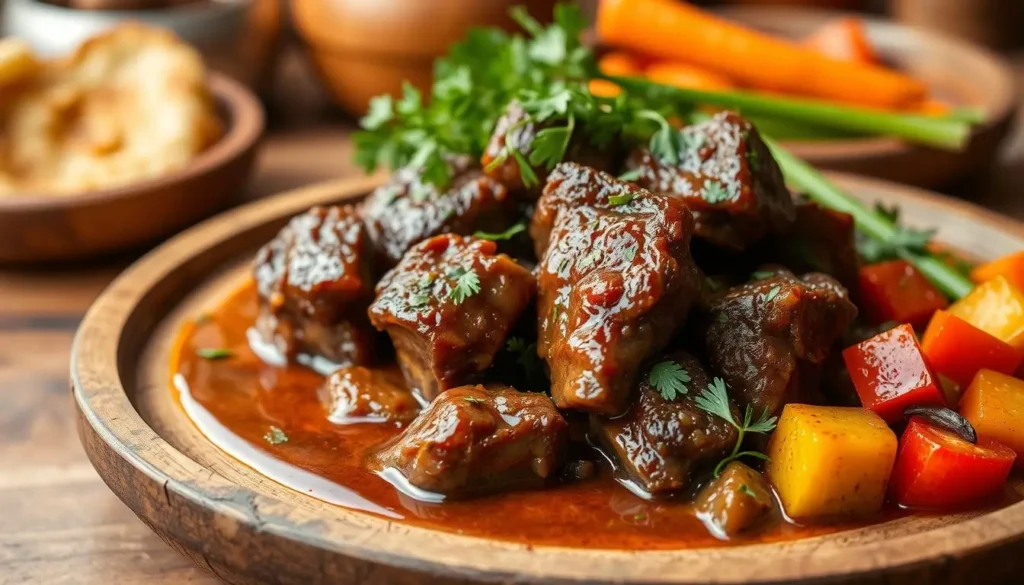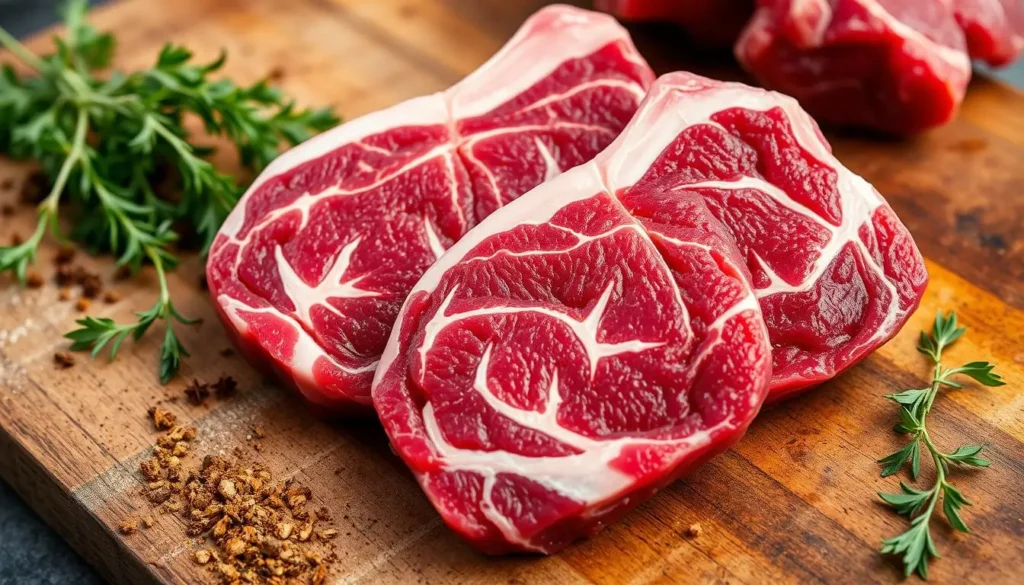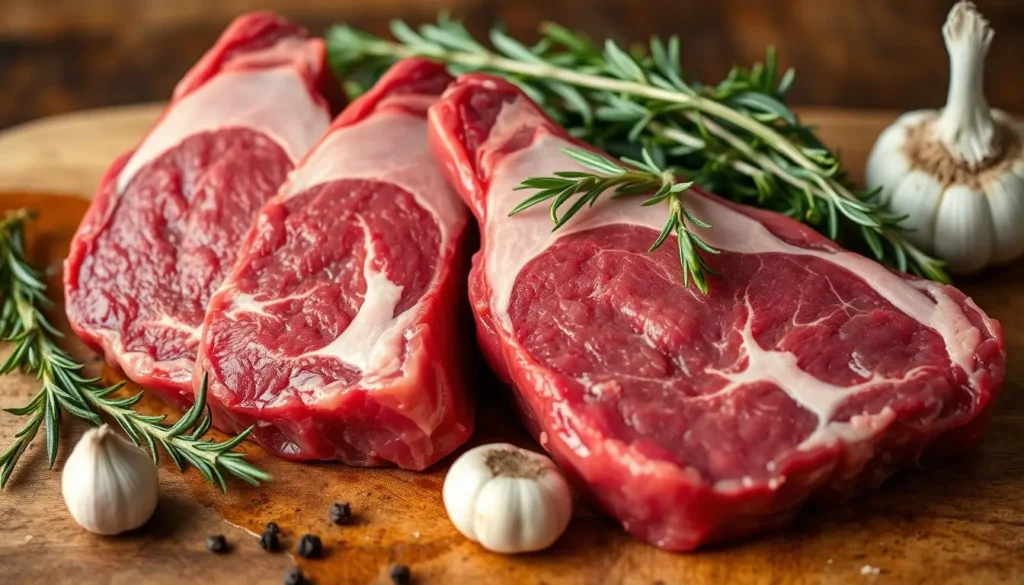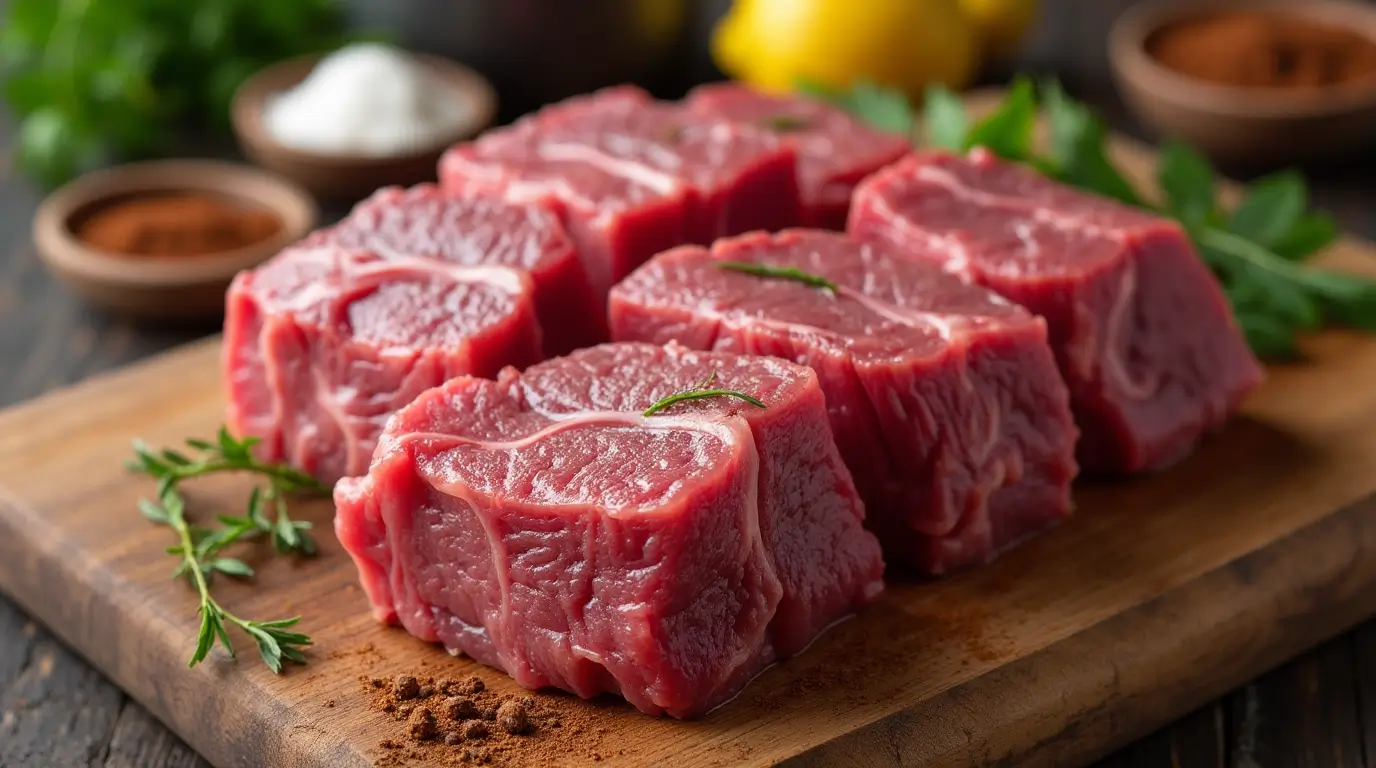Table of Contents
Beef Cheeks: Your Ultimate Guide to Perfectly Tender Recipes
Welcome to the world of slow-cooked delicacies, a culinary treasure that offers unmatched tenderness and flavor when prepared with care. Embark on an exciting journey to master the art of cooking these flavor-packed cuts. This comprehensive guide will help you select, prepare, and cook these succulent morsels to perfection, ensuring an unforgettable dining experience.
As you explore the realm of beef cheeks, you’ll discover the importance of cooking them to perfection. With the right techniques and tips, you can create a truly unforgettable culinary experience. Whether you’re a seasoned chef or a beginner in the kitchen, this guide will provide you with the necessary tools to create a delicious beef cheek dish.

Succulent beef cheeks braised in a rich, aromatic sauce, garnished with fresh herbs, served on a rustic wooden plate alongside vibrant seasonal vegetables, with a warm, inviting kitchen background.
Introduction to Cooking Beef Cheeks
Cooking beef cheeks demands patience, precision, and a desire to learn. This guide will introduce you to various techniques for preparing this delicate cut of meat. From selecting the finest pieces to mastering the art of cooking them to perfection, you’ll find everything you need to know here.
Key Takeaways
- Beef cheeks offer a tender and flavorful dining experience when cooked correctly
- Selecting the perfect cuts of beef is crucial for a delicious beef dish.
- Preparing and cooking beef to perfection is essential for a mouth-watering recipe.
- This guide will provide you with the necessary knowledge to create a delicious beef dish.
- Cooking beef cuts is an art that requires practice and patience.
- With the right techniques and tips, you can create a truly unforgettable culinary experience with braised beef.
What Are Beef Cheeks and Why They’re Special
Beef cheeks come from the cow’s cheek area. They are known for their rich flavor and tender texture. This makes them special.
Their mix of muscles, tendons, and connective tissue is perfect for slow cooking. This method breaks down the connective tissue, making them tender. Beef cheeks have a rich, beefy flavor that many love.
Anatomy and Characteristics
Beef cheeks are fascinating. They have muscles, tendons, and connective tissue. This makes them ideal for slow cooking.
The connective tissue breaks down during cooking. This results in a tender and flavorful dish.
Nutritional Benefits
Beef cheeks are not just tasty, but also nutritious. They are full of protein, vitamins, and minerals. They are great for a healthy diet.
- High protein content
- Rich in vitamins and minerals
- Low in fat
Flavor Profile and Texture
The flavor of beef cheeks is rich and beefy. They have a tender texture that melts in your mouth. Slow cooking brings out their full flavor and texture.

A close-up of beautifully marbled raw beef cheeks, showcasing their rich, deep red color and unique texture, set against a rustic wooden cutting board with a scattering of fresh herbs and spices around them, under natural light for enhanced detail.
Beef cheeks are a unique and delicious meat for slow cooking. They have a rich flavor and tender texture. They are perfect for anyone looking to try something new.
Selecting the Perfect Beef Cheeks
Choosing the right beef cuts is key for a tender and flavorful dish. Look for pieces that are fresh, have good fat distribution, and are the right size. Fresh beef should have a nice red color and a firm texture.
The fat distribution is important for keeping the meat moist. For tender beef, select cuts that are 1-2 pounds each. This depends on the number of people you’re serving and your cooking method. Here are some key factors to consider:
- Color: Opt for beef cheeks with a nice red color, indicating freshness.
- Fat distribution: Ensure the fat is evenly distributed throughout the cut.
- Size: Choose cuts that are around 1-2 pounds each for optimal cooking results.
By considering these factors, you’ll find the perfect beef cheeks for your recipe. This will result in tender and flavorful meat that impresses everyone.

A close-up view of freshly butchered beef cheeks, showcasing their rich marbling and deep red color, arranged on a wooden butcher block. Surrounding the beef are fresh herbs like rosemary and thyme, along with whole garlic cloves and a hint of cracked black pepper, all set in natural lighting to highlight the textures and details of the meat.
Remember, the quality of your beef cuts affects your dish’s final result. So, take your time to choose the best pieces available. With the right selection, you’ll create a delicious and memorable meal with tender beef.
| Factor | Description |
|---|---|
| Color | Nice red color, indicating freshness |
| Fat distribution | Even distribution throughout the cut |
| Size | Around 1-2 pounds each for optimal cooking results |
Essential Preparation Steps for Beef Cheeks
To make delicious beef cheeks, follow some key steps. These steps ensure the meat is tender and full of flavor. Start by trimming off any extra fat or connective tissue. This helps the meat cook evenly and stay tender.
Then, wash them under cold water and dry them with paper towels. This step removes impurities and helps the meat soak up marinade flavors. Using a marinade is a great way to add taste. Mix olive oil, garlic, and herbs for a tasty marinade.
Trimming and Cleaning
- Trim excess fat or connective tissue from the beef cheeks
- Clean them under cold running water
- Pat them dry with paper towels
Marinating Techniques
Marinating is a must for beef cheeks. You can mix different ingredients for a tasty marinade. For instance, olive oil, garlic, and herbs make a great mix. Here’s a simple marinade recipe:
| Ingredient | Quantity |
|---|---|
| Olive oil | 1/4 cup |
| Garlic | 3 cloves |
| Herbs | 1 tablespoon |
Seasoning Guidelines
Seasoning is key when preparing beef cheeks. Use salt, pepper, and spices to boost the flavor. For braised beef cheeks, mix marinating and seasoning for a rich taste.
Best Cooking Methods for Tender Beef Cheeks
There are several methods to cook beef cheeks for tender, flavorful results. To make a delicious beef cheeks stew, combine different techniques. Braising the meat in liquid over low heat for an extended period ensures it becomes wonderfully tender.
Here are some cooking methods to try:
- Braising: Cook the beef cuts in liquid over low heat for 2-3 hours.
- Slow cooking: Use a slow cooker or Dutch oven to cook the beef for 8-10 hours.
- Pressure cooking: Cook them for 30-40 minutes to reduce cooking time while retaining flavor and tenderness.
You can use these methods alone or together for a rich braised beef stew. For instance, braise it in a Dutch oven and then slow cook the beef. This makes it tender and juicy.
Choosing the right cooking method is key to a delicious beef stew. Whether braising, slow cooking, or pressure cooking, the secret is to cook it slowly. This breaks down the connective tissue, making the meat tender and flavorful.
| Cooking Method | Cooking Time | Result |
|---|---|---|
| Braising | 2-3 hours | Tender and flavorful |
| Slow Cooking | 8-10 hours | Fall-apart tender |
| Pressure Cooking | 30-40 minutes | Tender and juicy |
Creating the Perfect Beef Cheeks Sauce
To make your dish even better, a rich sauce is key. You can choose from many sauces, like a classic red wine reduction or a hearty beef broth sauce. The secret to a great sauce is to simmer it slowly. This lets the flavors get stronger and the liquid thicken into a syrup.
When making a sauce for your beef cheeks, think about these ingredients:
- Red wine for a deep, fruity flavor
- Beef broth for added richness and moisture
- Tomato paste for a burst of acidity and flavor
- Herbs and spices, such as thyme and rosemary, to enhance the aroma and taste
A good sauce can really change how your dish tastes and feels. By trying out different ingredients and methods, you can find a sauce that matches the meat perfectly.
Some favorite sauces include:
- Bourguignon sauce, made with red wine, onions, and mushrooms
- Peppercorn sauce, featuring a creamy mixture of black peppercorns and heavy cream
- Horseradish sauce, adding a pungent kick to the dish
The best sauce for your beef cuts depends on your preferences and the flavor you desire. By following these tips and experimenting with new ideas, you can create a delicious braised meat dish. It will surely impress your family and friends.
| Sauce Option | Ingredients | Flavor Profile |
|---|---|---|
| Bourguignon Sauce | Red wine, onions, mushrooms | Rich, fruity, earthy |
| Peppercorn Sauce | Black peppercorns, heavy cream | Creamy, spicy, aromatic |
| Horseradish Sauce | Horseradish, sour cream | Pungent, tangy, creamy |
Common Mistakes to Avoid When Cooking Beef Cheeks
Learning to cook braised beef requires understanding common mistakes that can affect the dish’s quality.
To prevent overcooking or undercooking, controlling temperature and timing is essential. Use a thermometer and timer to ensure the beef cuts reach the right internal temperature.
Temperature Control Issues
Temperature control is crucial for meat. Too high a temperature can make the meat tough and dry. Too low, and it won’t cook evenly.
Timing Mistakes
Timing is also vital. If the meat isn’t cooked long enough, it can become tough or dry. Cooking for 2-3 hours is recommended for tender and flavorful results.
Seasoning Errors
Seasoning is a key part of cooking beef cheeks. Too much or too little seasoning can change the dish’s flavor. Taste the meat as you go and adjust the seasoning.
Avoiding these mistakes will help you cook tender and flavorful beef cuts. Always follow a recipe and use the right techniques for the best results.
Serving Suggestions and Pairings
There are many ways to serve beef cheeks. You can pair it with mashed potatoes, polenta, or roasted veggies. For a traditional taste, try it with egg noodles or crusty bread.
Adding fresh herbs or microgreens can make the dish look great. Here are some great pairings :
- Red wine, such as Cabernet Sauvignon
- Roasted veggies like Brussels sprouts or carrots
- Mashed potatoes or polenta
- Egg noodles or crusty bread
Creating a beef cheeks dish is fun and allows you to try new flavors. Serving it with different sides and wines can make your meal unforgettable.
Many chefs and restaurants have their own recipes. Whether you’re a pro or a beginner, serving beef cheeks can wow your guests and make a memorable meal.
Conclusion: Mastering the Art of Beef Cheek Preparation
Learning to cook braised beef well takes time and effort. But the delicious results make it all worth it. Follow the steps in this guide to bring out the best in this tasty meat.
Choose the best beef cuts and use the right cooking methods. This way, you’ll get a dish that’s tender and full of flavor.
With time, you’ll get better at cooking. You’ll impress everyone with your dishes. Try new sauces and spices to add your own twist. Let the beef cheeks be the star, but add your own flair too.
This guide is your starting point on the cooking journey. Enjoy the learning process and be proud of your creations. Happy cooking!
FAQ
What are beef cheeks?
Beef cheeks come from the cow’s cheek area. They are known for their rich flavor and tender texture when cooked right.
What are the nutritional benefits of beef cheeks?
Beef cheeks are packed with nutrients like protein, vitamins, and minerals. They are a great source of essential nutrients for your body.
How do I select the perfect beef cheeks?
Look for fresh beef cuts with good fat distribution and the right size. Fresh ones have a nice red color and firm texture. Good fat distribution keeps the meat moist during cooking.
What are the essential preparation steps ?
First, trim excess fat or connective tissue. Then, clean them under cold running water. Marinate to add flavor and season with salt, pepper, and spices.
What are the best cooking methods for tender beef cheeks?
Braising, slow cooking, and pressure cooking are the best methods. They break down connective tissue, making the meat tender and fall-apart.
How do I create the perfect sauce for my dish?
Use red wine, beef broth, and tomato paste for the sauce. Reduce it over low heat to make it thick and syrupy. This enhances the meat’s flavor.
What are some common mistakes to avoid when cooking beef cheeks?
Avoid not controlling temperature, not timing cooking, and seasoning errors. Follow a recipe, use a thermometer, and taste as you go to adjust seasoning.


2 thoughts on “Beef Cheeks : The Ultimate Guide to Tender, Flavorful Meat”
Comments are closed.